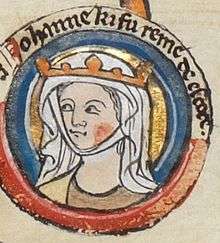Joan of England, Queen of Scotland
| Joan of England | |
|---|---|
 | |
| Queen consort of Scotland | |
| Tenure | 21 June 1221 – 4 March 1238 |
| Born | 22 July 1210 |
| Died |
4 March 1238 (aged 27) Havering-atte-Bower |
| Burial | Tarrant Abbey, Dorset |
| Spouse |
Alexander II, King of Scots (m. 1221) |
| House | Plantagenet |
| Father | John, King of England |
| Mother | Isabella of Angoulême |
Joan of England (22 July 1210 – 4 March 1238), was Queen consort of Scotland from 1221 until her death.[1][2] She was the third child of John, King of England[3] and Isabella of Angoulême.
Life
Joan was sought of as a bride by Philip II of France for his son. In 1214, however, father king John, promised her in marriage to Hugh X of Lusignan, as compensation for him being jilted by her mother Isabella. She was promised Saintes, Saintonge and the Isle of Oléron as dowry, and sent to her future spouse at that year, to be brought up at his court until marriage. Hugh X laid claim on her dowry already prior to their marriage, but when this did not succeeded, he reportedly became less eager to marry her.
On the death of John of England in 1216, queen dowager Isabella decided she should marry Hugh X herself. Hugh X kept Joan with him in an attempt to keep her dowry as well as having the dowry of her mother Isabella released from the English. On 15 May 1220, after an intervention from the Pope and an agreement of the dowry, Joan was sent back to England where negotiations for her hand with Alexander II of Scotland were taking place. Alexander had been in England in 1212, where he had been knighted by her father. It is alleged that King John had promised to give him Joan as a bride and Northumberland as her dowry.
On 18 June 1221, Alexander officially settled the lands Jedburgh, Hassendean, Kinghorn and Crail to Joan as her personal income. She and Alexander married on 21 June 1221, at York Minster.[4] Alexander was twenty-three. Joan was ten, almost eleven. They had no children. This fact was a matter of concern, but an annulment of the marriage was regarded as risky as it could provoke war with England. Queen Joan did not have a strong position at the Scottish court, which was dominated by her mother in law, queen dowager Ermengarde. Her English connections nevertheless made her important regardless of her personal qualities. Joan accompanied Alexander to England in September 1236 at Newcastle, and in September 1237 at York, during the negotiations with her brother King Henry over disputed northern territories. At this point, chronicler Matthew Paris suggest that Joan and Alexander had became estranged and that Joan wished to spent more time in England, and her brother king Henry granted her manors in Driffield, Yorkshire and Fen Stanton in Huntingdonshire to reside if needed. In York, Joan and her sister-in-law Eleanor of Provence agreed to make pilgrimage to Thomas Becket’s shrine in Canterbury.
Joan died in the arms of her brothers King Henry and Richard of Cornwall at Havering-atte-Bower in 1238, and was buried at Tarrant Crawford Abbey in Dorset in accordance with her wishes.[5][6] Henry III continued to honour Joan’s memory for the rest of his life. Most dramatically, in late 1252, almost fourteen years after her death, Henry ordered the production of the image of a queen in marble for Joan’s tomb, at the cost of 100s. This was one of the first funerary effigies of a queen in England; the tradition developed in the early thirteenth century, but the tombs of Eleanor of Aquitaine and Berengaria of Navarre were in France. Nothing now remains of this church; the last mention of it is before the Reformation. It is said that she is now buried in a golden coffin in the graveyard.
Ancestors
| Ancestors of Joan of England, Queen of Scotland | ||||||||||||||||||||||||||||||||||||||||||||||||||||||||||||||||||||||||||||||||||||||||||||||||||||||||||||||||||||||||||||||||||||||||||||||||||||||||||||||||||||||||||||||||||||||||||||||||||||||||||||||||||||||||||||||||||||||||||||||||||||||||||||||||||||||||||||||||||||||||||||||||||||||||||||||||||||||||||||||||||||||||||||||||||||||||||||||||||||||||||||||||||||||||||||||||||||||||||||||||||||||||||||||||||||||||||||||||||||||||||||||||||||||||||||||||||||||||||||||||||||||||||||||||||||||||||||||||||
|---|---|---|---|---|---|---|---|---|---|---|---|---|---|---|---|---|---|---|---|---|---|---|---|---|---|---|---|---|---|---|---|---|---|---|---|---|---|---|---|---|---|---|---|---|---|---|---|---|---|---|---|---|---|---|---|---|---|---|---|---|---|---|---|---|---|---|---|---|---|---|---|---|---|---|---|---|---|---|---|---|---|---|---|---|---|---|---|---|---|---|---|---|---|---|---|---|---|---|---|---|---|---|---|---|---|---|---|---|---|---|---|---|---|---|---|---|---|---|---|---|---|---|---|---|---|---|---|---|---|---|---|---|---|---|---|---|---|---|---|---|---|---|---|---|---|---|---|---|---|---|---|---|---|---|---|---|---|---|---|---|---|---|---|---|---|---|---|---|---|---|---|---|---|---|---|---|---|---|---|---|---|---|---|---|---|---|---|---|---|---|---|---|---|---|---|---|---|---|---|---|---|---|---|---|---|---|---|---|---|---|---|---|---|---|---|---|---|---|---|---|---|---|---|---|---|---|---|---|---|---|---|---|---|---|---|---|---|---|---|---|---|---|---|---|---|---|---|---|---|---|---|---|---|---|---|---|---|---|---|---|---|---|---|---|---|---|---|---|---|---|---|---|---|---|---|---|---|---|---|---|---|---|---|---|---|---|---|---|---|---|---|---|---|---|---|---|---|---|---|---|---|---|---|---|---|---|---|---|---|---|---|---|---|---|---|---|---|---|---|---|---|---|---|---|---|---|---|---|---|---|---|---|---|---|---|---|---|---|---|---|---|---|---|---|---|---|---|---|---|---|---|---|---|---|---|---|---|---|---|---|---|---|---|---|---|---|---|---|---|---|---|---|---|---|---|---|---|---|---|---|---|---|---|---|---|---|---|---|---|---|---|---|---|---|---|---|---|---|---|---|---|---|---|---|---|---|---|---|---|---|---|---|---|---|---|---|---|---|---|---|---|---|---|---|---|---|---|---|---|---|---|---|---|---|---|---|---|---|---|---|---|---|---|---|---|---|---|---|---|---|---|---|---|---|---|---|---|---|---|---|---|---|---|---|---|---|---|---|---|---|---|---|---|---|---|---|---|---|---|---|---|---|---|---|---|---|---|---|---|---|---|---|---|---|---|---|---|---|---|---|---|---|---|---|---|---|---|---|---|---|---|---|---|---|
| ||||||||||||||||||||||||||||||||||||||||||||||||||||||||||||||||||||||||||||||||||||||||||||||||||||||||||||||||||||||||||||||||||||||||||||||||||||||||||||||||||||||||||||||||||||||||||||||||||||||||||||||||||||||||||||||||||||||||||||||||||||||||||||||||||||||||||||||||||||||||||||||||||||||||||||||||||||||||||||||||||||||||||||||||||||||||||||||||||||||||||||||||||||||||||||||||||||||||||||||||||||||||||||||||||||||||||||||||||||||||||||||||||||||||||||||||||||||||||||||||||||||||||||||||||||||||||||||||||
Notes
| Wikimedia Commons has media related to Joan of England (1238). |
- ↑ Annales de Dunstaplia
- ↑ Annales de Theokesberia
- ↑ The Annals of Worcester
- ↑ Agnes Mure Mackenzie, The Foundations of Scotland (1957), p. 251.
- ↑ Mackenzie, p. 260.
- ↑ A Medieval Chronicle of Scotland: The Chronicle of Melrose
References
- Rosalind K. Marshall: “Scottish Queens: 1034-1714”
- Richard Oram: “The Kings and Queens of Scotland”
- Timothy Venning: “The Kings and Queens of Scotland”
- Mike Ashley: “British Kings and Queens”
- Elizabeth Ewan, Sue Innes and Sian Reynolds: “The Biographical Dictionary of Scottish Women”
| Preceded by Ermengarde de Beaumont |
Queen consort of Scotland 1221–1238 |
Succeeded by Marie de Coucy |
.svg.png)